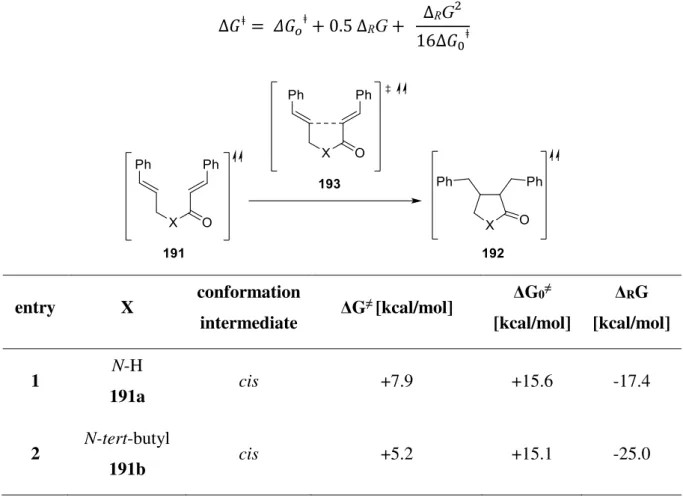via visible light
Dissertation
zur Erlangung des Doktorgrades der Naturwissenschaften Dr. rer. nat.
der Fakultät für Chemie und Pharmazie der Universität Regensburg
vorgelegt von Sabine Martha Kerres
aus Burglengenfeld
Regensburg 2018
Die Arbeit wurde angeleitet von: Prof. Dr. O. Reiser Promotionsgesuch eingereicht am: 09.07.2018
Promotionskolloquium am: 21.09.2018
Prüfungsausschuss: Vorsitz: Prof. Dr. R. Müller
1. Gutachter: Prof. Dr. O. Reiser 2. Gutachter: Prof. Dr. D. J. Aitken 3. Gutachter: Prof. J. Wegener
Dezember 2017 am Lehrstuhl von Prof. Dr. Oliver Reiser, Institut für Organische Chemie, Universität Regensburg, angefertigt.
Herrn Prof. Dr. Oliver Reiser möchte ich herzlich für die Überlassung des interessanten Themas, die anregenden Diskussionen und seine stete Unterstützung während der Durchführung dieser Arbeit danken.
Für Florian und meine Familie
Freiheit bedeutet, dass man nicht unbedingt alles so machen muss, wie andere Menschen.
(Astrid Lindgren)
Å angstrom
Ac acetyl
ACHC amino cylcohexane carboxylic acid
AcOH acetic acid
ACC amino cyclopropane carboxylic acid
ACBC amino cyclobutane carboxylic acid
ACPC amino cyclopentane carboxylic acid
APC amino pyrrolidine carboxylic acid
aq. aqueous
Boc tert-butyloxycarbonyl bp boiling point
bpy bipyridine bpz 2,2'-bipyrazine
brine saturated NaCl solution
Bu butyl
°C degrees Celcius calc. calculated CBz carboxybenzyl
CFL compact fluorescent light bulb cm-1 wavenumbers
conv. conversion
CV cyclic voltammetry
d day(s)
D electron donor
dap 2,9-bis(para-anisyl)-1,10- phenanthroline
DCC N,N’-
dicyclohexylcarbodiimide DCM dichloromethane
decomp. decomposition
DEE diethyl ether
DEPT distortionless enhancement by polarization transfer
dF(CF3)ppy (2-(2,4-difluorophenyl)- 5(trifluoromethyl)pyridine DIPEA N,N-diisopropylethylamine DMA N,N-dimethylaminiline
DMAP N,N-dimethyl-4-aminopyridine DMF dimethylformamide
DMSO dimethylsulfoxide dr diastereomeric ratio
dtp-bpy 4,4'-di-tert-butyl-2,2'-dipyridyl ET triplet energy
E1/2 standard reaction potential EDC 1-ethyl-3-
(3-dimethylaminopropyl)carbodiimide ee enantiomeric excess
equiv. equivalent(s)
ESI electrospray ionization et al. and others
Et ethyl
ET energy transfer EtOAc ethyl acetate
fac facial
Fmoc fluorenylmethyloxycarbonyl GABA γ-amino butyric acid
h hour(s)
hν light
HMDS hexamethyldisilazane HP high pressure
HPLC high performance liquid chromatography
HRMS high resolution mass spectrometry IBX 2-iodoxybenzoic acid
i-Pr iso-propyl
K reaction constant L* chiral ligand LED light-emitting diode
li. liquid
LMCT ligand to metal charge transfer
M molar
Me methyl
MeCN acetonitrile
MHz megahertz
min minute(s)
MLCT metal to ligand charge transfer mp. melting point
MS mass spectrometry
MV methyl viologen
NAC near attack conformation
NBS N-bromosuccinimide
nBuLi n-butylithium
nm nanometer(s)
NMR nuclear magnetic resonance
PC photocatalyst
PET photoinduced electron transfer Pg protecting group
Ph phenyl
ppm part(s) per million ppy 2-phenylpyridine R arbitrary rest Rf retention factor
rac racemic
RP reversed phase Rf retention factor rt room temperature
SCE saturated calomel electrode
Su succinimide
T temperature
TBAF tetrabutylammonium fluoride
TS transition state TFA trifluoroacetic acid
TFMSA trifluoromethanesulfonic acid THF tetrahydrofuran
TLC thin-layer chromatography UV ultraviolet
V Volt
W Watt
vs versus
X arbitrary moiety
A Introduction ... 1
1 [2+2] Cycloaddition ... 1
2 [2+2] Photocycloaddition via first excited singlet state S1 ... 3
3 Copper(I)-catalyzed [2+2] photocycloaddition ... 6
4 [2+2] Photocycloaddition via first excited triplet state T1 ... 8
5 [2+2] Photocycloaddition via energy transfer ... 12
6 [2+2] Photocycloaddition via photoinduced electron transfer ... 15
7 References ... 19
B Main Part ... 23
1 Preliminary studies towards the synthesis of the bicyclic key intermediates ... 23
1.1 Introduction ... 23
1.2 Studies towards [2+2] photocycloaddition via radical anion mechanism ... 26
1.3 Studies towards [2+2] photocycloaddition via radical cation mechanism ... 35
1.4 Studies towards [2+2] photocycloaddition via energy transfer ... 39
2 Synthesis of precursors for [2+2] photocycloaddition ... 42
2.1 Synthesis of amines ... 42
2.2 Synthesis of acids ... 44
2.3 Synthesis of amide-linked dienes ... 46
3 Theoretical studies towards the reaction mechanism of [2+2] photocycloaddition of amide-linked dienes ... 49
4 Optimization of reaction conditions of [2+2] photocycloaddition ... 53
5 Substrate scope of the [2+2] photocycloaddition ... 58
6 Upscaling of the [2+2] photocycloaddition ... 61
7 Transformation of the bicyclic key intermediates into racemic γ-cyclobutane amino acid ... 63
7.1 Removal of the tert-butyl group ... 63
7.2 Studies towards debenzylation ... 66
7.3 Hydrolysis of the N-Boc derivatives ... 70
7.4 Conclusion ... 71
8 Chiral resolution ... 72
9 Second synthetic route towards enantioselective γ-cyclobutane amino acids ... 74
10 Synthesis of chiral 3-(aminomethyl)-5-phenylpentanoic acid ... 78
11 Neuropeptide Y analogues ... 83
11.1 Neuropeptide Y ... 83
11.2 Incorporation of γ-cyclobutane amino acids ... 85
12 References ... 88
E Experimental Part ... 101
1 General information ... 101
2 Syntheses of compounds ... 103
3 DFT-calculations ... 169
4 References ... 215
F Appendix ... 218
1 NMR spectra... 218
2 HPLC chromatograms ... 300
3 X-ray crystallographic data ... 319
4 Curriculum Vitae ... 383
G Acknowledgment ... 385
H Declaration ... 388
A Introduction 1 [2+2] Cycloaddition
The cyclobutane motif is ubiquitous in a wide range of natural products. Molecules containing these small ring systems are versatile molecular building blocks in organic synthesis since their inherent ring strain enables a selective cleavage of a cyclobutane bond.[1] Thus they can serve as key intermediates to build up complex molecule structures by ring contraction, ring expansion or ring opening.[2] Furthermore, cyclobutane derivatives find great application in catalytical processes.[3] During the last decades, several research groups have been working on the development to get access to such molecules. Besides C-H activation[4], direct ring closure[5]
and radical cyclization to form cyclobutanes, they are also accessible by cyclopropanes[6] or sugar derivatives[7]. However, the most frequently used method to synthesize cyclobutanes is the [2+2] cycloaddition.[8]
“A cycloaddition reaction is a ring forming addition of “m” number of atoms of one group to
“n” number of atoms of another group; if both groups are part of the same molecule the cycloaddition is intramolecular and if both groups are part of different molecules the cycloaddition is intermolecular […] Most cycloadditions are characterized by the formation of two new sigma bonds as the ring is being formed.”[9]
The unambiguous advantage of this reaction type is the generation of multiple bonds and stereocenters in a single step what makes this reaction a powerful and meaningful method to build up natural products, biologically active molecules and other complex structures. This type of reaction can either take place thermally or photochemically. According to the Woodward- Hoffmann rules[10], a thermal [2+2] cycloaddition is symmetrically allowed antara-supra-facial what is unfavorable for substituted alkenes due to steric reasons. Some exceptions herein represent cycloadditions of molecules which possess two double bonds to the same carbon and therefore two -bonds at right angles as for example ketenes[11], isocyanates[12] or allenes[13]. The thermal [2+2] cycloaddition of ketenes with alkenes forms cyclobutanones whereas the reactions of ketene with imines or chlorosulfonyl isocyanates with alkenes construct -lactams.
Furthermore, the thermal [2+2] cycloaddition of allenes allows the introduction of exomethylene moieties at the four-membered ring.[14]
More attention has been paid to the extensively studied photochemical [2+2] cycloaddition since it is symmetrically allowed in a suprafacial-suprafacial manner. In 1908, Cíamician and
coworkers described the earliest example of a [2+2] photocycloaddition: the transformation of carvone 1 to carvone camphor 2 by exposure to sunlight for one year (Scheme 1).[15]
Scheme 1. Conversion of carvone to carvone camphor, reported by Cíamician et al.[15]
The first synthetic applications were developed by Corey[16] and Eaton[17] with the syntheses of caryophyllene 3, a sesquiterpene, which is an ingredient of several essential oils, and cubane 4 as strained energy-rich molecule. Numerous natural and unnatural compounds have been prepared having a [2+2] photocycloaddition as crucial step in their syntheses.[18] Depending on the involved substrate different classes of this reaction can be described: [2+2]
photocycloaddition of alkenes, enone-photocycloaddition, metal-catalyzed [2+2]
photocycloaddition, de Mayo reaction or the Paternò-Büchi reaction. A selection of some representative examples is illustrated in figure 1.[19,20]
Figure 1. Representative examples of photochemical [2+2] photocycloaddition.
Depending on the used substrates, reagents and excitation mode the [2+2] photocycloaddition occurs via different mechanistic pathways.[21] On the one hand, direct excitation of a reacting partner can generate its excited singlet state S1 and by a subsequent intersystem crossing (ISC) also its excited triplet state T1 both of which can react with another alkene in its ground state giving rise to cyclobutane derivatives. On the other hand, the presence of an additive absorbing the light the [2+2] photocycloaddition can be performed either by an energy transfer or by a photoinduced electron transfer (PET) from this photoexcited species to the reactant. In the following chapter, the different reaction modes will be discussed in more detail and be exemplified by synthetic examples.
2 [2+2] Photocycloaddition via first excited singlet state S
1The direct excitation of an alkene from its ground state S0 11 leads to its first excited state S1 12.
A subsequent addition to another ground state alkene 13 is called photocycloaddition, giving rise to the cyclobutane compound 15. The reaction either occurs in a concerted manner or via a generation of an exciplex 14 (Scheme 2).[22]
Scheme 2. Reaction mechanism of [2+2] photocycloaddition via S1.[22]
Since the excited state S1 is mostly dominated by * character, the cis-trans isomerization usually displays the competitive reaction, what serves as very fast radiationless energy decay.[22]
This issue can be circumvented by using constrained molecules, as cycloalkenes with a ring size from three to five or performing the reaction in a rigid environment.[23] Therefore, there is only a limited number of singlet excited [2+2] photocycloadditions of acyclic alkenes in solution. For example, in the case of liquid trans-2-butene (16) and cis-2-butene (17) their inefficient dimerizations compete with efficient cis-trans isomerization. Irradiation of trans-2- butene (16) led stereospecifically to tetramethyl cyclobutanes 18 and 19 and cis-2-butene (17) reacted to dimers 19 and 20 at low conversion, respectively. At high reagent concentration, the
cycloaddition competes effectively with the cis-trans isomerization resulting in reduced product selectivity (Scheme 3).[9,24,25]
Scheme 3. Photocycloaddition of acyclic olefin.
Furthermore S1 (*) has a very short lifetime and the intersystem crossing (ISC) towards the more long-lived first triplet state T1 (*) is generally too slow to be efficient due to a very large singlet-triplet energy gap (typically > 40 kcal/mol).[9] Additionally, direct irradiation of simple alkenes is quite a challenge since they exhibit an absorption maximum λmax less than or equal to 200 nm. Conventional light sources are mercury vapor lamps which are commercially available in three different types: low-, medium- and high-pressure. They differ in their spectral characteristic. The low-pressure mercury lamp emits light mainly at 253.7 nm, the weak band of 184.9 nm can be cut off by a suitable filter. Whereas the medium-pressure mercury lamp exhibits spectral lines at 265.4, 313 and 365 nm which are broadened in the case of the high- pressure mercury lamp leading roughly to a continuum.[26]
Aryl substituted alkenes absorb light at longer wavelengths and represent more suitable substrates for the [2+2] photocycloaddition via excited singlet state S1. Exemplary, the state energy diagrams of cis-cyclooctene (21), 1,3-butadiene (22), trans--methylstyrene (23) and trans-stilbene (24) are illustrated in figure 2.[9]
Figure 2. Representative state energy diagrams of alkenes.
Another advantage of aryl alkenes is that some of them possess a small energy barrier for the rotation around their C=C bond what makes the energy dissipation by cis-trans isomerization more difficult.[9,27,28]
In 2007, Abramić et al.[29] build up amidino-benzimidazole derivative 26 in a yield of 80%
using an intermolecular [2+2] photocycloaddition of 1,2-diarylalkenes as key step in their synthesis. Herein the corresponding monomer 25 was directly irradiated in water by a 400 W high-pressure mercury lamp applying a Pyrex filter (Scheme 4). By introduction of the cyclobutane moiety as rigid conformation element, the inhibitory potential against dipeptidyl peptidase III which is involved in the mammalian pain modulatory system could be significantly improved.
Scheme 4. Synthesis of amidino-benzimidazole 26 as an inhibitor of dipeptidyl peptidase III.
The group of Nishimura extensively applied an intramolecular variant of the [2+2]
photocycloaddition occurring via the first excited singlet state S1 to synthesize cyclophanes[30]
as shown in compound 27 or crownethers[31] 28 (Figure 3).
Figure 3. Exemplary structures of a cyclophane 27 and crownether 28.
Fleming and coworkers performed their [2+2] photocycloaddition with silyl-tethered aryl alkenes that bears the advantage of pre-organization of the reactant alkenes.[32] Hence a better control of the regio- and stereochemistry of this reaction could be achieved. Since the likelihood of a collision of both affected double bonds could be increased by this manner, the competitive cis-trans isomerization could be minimized. The [2+2] photocycloaddition of the cinnamoyloxy silane 29 gave only one diastereomer 30 which was subsequently treated with ammonium fluoride to achieve the removal of the covalent bridge. Cyclobutane 31 could be obtained in an excellent yield of 94% (Scheme 5).[33]
Scheme 5. Singlet [2+2] photocycloaddition of silyl-tethered derivatives, described by Fleming et al.[33]
3 Copper(I)-catalyzed [2+2] photocycloaddition
[27,34]In the presence of transition metal salts, a direct excitation of non-conjugated alkenes becomes feasible due to the bathochromic shift of their absorption maxima from around 200 nm to 240 nm. The most frequently used metal species were Cu(I) salts, especially the commercially available Cu(OTf) in benzene or toluene. At first, the reacting alkene moieties coordinate to a single copper(I) cation to form a ground state complex 32. By photoexcitation of this bis- alkene-Cu(I) complex 32 the cyclobutane formation and regeneration of the Cu(I) catalyst are accomplished either via a metal-ligand or ligand-metal charge transfer (MLCT 33 or
LMCT 34). The mechanism as concerted [2+2] photocycloaddition was also proposed (Scheme 6).
Scheme 6. Mechanism of Cu(I)-catalyzed [2+2] photocycloaddition.[22]
This methodology was especially applied for [2+2] photodimerization of the endo- dicyclopentadiene 37 giving rise to 88% of the dimer 38. Interestingly, in the presence of a triplet sensitizer as acetone compound 37 reacted via an intramolecular [2+2]
photocycloaddition to the cage hydrocarbon compound 39. Probably due to steric reasons, the complexation of the double bonds of two substrate molecules 37 is preferred over the one of both alkene moieties of one substrate molecule 37 (Scheme 7).[35]
Scheme 7. Intermolecular and intramolecular [2+2] photocycloaddition of endo-dicyclopentadiene.
The generality as well as the scope of the intramolecular variant of this reaction type has been extensively studied by the groups of Salomon[36] and Ghosh[37]. Suitable substrate classes represent 1,6-heptadienes, diallyl ethers, homoallyl vinyl ethers and N,N-diallyl carbamates. In this manner, a huge variety of natural products and biologically active compound could be generated. Cyclobut-A 42, a nucleoside analogue of the naturally occurring antibiotic oxetanocin, which exhibit remarkable antiviral activity, was synthesized by Ghosh et al.[38]
using a stereoselective intramolecular Cu(I)-catalyzed [2+2] photocycloaddition as essential reaction step (Scheme 8). In the presence of Cu(OTf) the solution of triene 40 in diethyl ether was irradiated by a medium-pressure mercury lamp (450 W) through a double-walled water- cooled quartz immersion well (λirr > 250 nm) yielding 70% of an inseparable mixture of four
diastereomers 41. The reason for obtaining diastereomers 41 is the exocyclic double bond.
However, the mixture could be taken for the further synthesis towards cyclobut-A 42, since this double bond was oxidatively cleaved off and the stereocenter at the cyclobutane ring was epimerized during the reaction sequence.
Scheme 8. The key step of the synthesis towards cyclobut-A 42, reported by Ghosh et al.[38]
4 [2+2] Photocycloaddition via first excited triplet state T
1[22,27,39,40]Alkenes whose double bond is in conjugation with a carbonyl group can react in the [2+2]
photocycloaddition via their first excited triplet state T1. Typical excitation wavelengths of ,- unsaturated carbonyl, carboxyl and related heterocyclic compounds are over 250 nm.[41]
Therefore, they are accessible by commercially available light sources and also suitable cut off filter can be used in order to avoid side reactions by irradiation with short wavelengths light.
Since their excited singlet state S1 is of n* character, the intersystem crossing takes place very fast and the cyclobutanation occurs from the lowest lying triplet state T1 possessing mainly *
character.[42] Especially, cyclic 5- or 6-membered alkenones are widely employed substrate classes for this reaction type. Herein no energy dissipation by isomerization over the C=C double bond can take place.[43] By direct excitation of cyclopentenone 43 the first excited singlet state S1 can be reached. By rapid intersystem crossing the long-lived triplet state 45 can be generated followed by the formation of an exciplex 47 with a ground state alkene 46.[44] This complex 47 can either decay to the triplet 1,4-biradicals 48 and 49 or competitively to the ground state reactants 43 and 46.[45] Weedon and coworkers confirmed the formation of the 1,4- biradical intermediates during the [2+2] photocycloaddition by trapping them with hydrogen selenide.[46] By a further intersystem crossing the singlet 1,4-biradicals 50 and 51 were obtained which either cyclize to the desired cyclobutane derivative 52 or revert to the starting material.[39,47]
Scheme 9. Reaction mechanism of [2+2] photocycloaddition of cyclopentenone 43.
Advantageously, the T1 state represents a more long-lived species so that a cycloaddition of an excited enone with a ground state alkene, which is normally used in excess, becomes more likely. However, in contrast to the singlet [2+2] photocycloaddition where the stereochemistry of the starting material is preserved the stereocontrol during the triplet reaction is lost due to the formation of 1,4-biradical intermediates. On the one hand, the regioselectivity is controlled by the stability of the 1,4-biradical and on the other hand, it is influenced by the ratio between the cleavage of the singlet 1,4-biradicals to the ground state starting material and the cyclization to the product.[48]
In intermolecular [2+2] photocycloadditions of enones with alkenes, the regioselectivity depends to a certain extent on the substitution pattern of the alkene. The excited state of an enone displays an inverted polarity in contrast to its ground state (Umpolung).[49] Therefore, electron-rich alkenes prefer a head-to-tail conformation whereas electron poor ones a head-to- head conformation. In the reaction of lactam 53 with acrylonitrile 54 compound 56a with the 1,2-relationship to the carbonyl represents the major product and with ethyl vinyl ether 55 isomer 57b with the 1,3-relationship, respectively.[50]
Scheme 10. [2+2] photocycloaddition of lactam 53 with an acceptor olefin 54 vs with a donor olefin 55.
Applying cyclopentenone as substrate leads always to a cis-fusion at the cyclobutane ring whereas also a trans-fusion can be obtained in the case of cyclohexanone because of the twisted conformation of its excited state.[16,44]
Good diastereoselectivity can be easily achieved by the introduction of chirality to the enone derivative as for example a substituent in -position to the carbonyl moiety or by using a bicyclic enone since the alkene will preferably attack from the less shielded side. Piers et al.[51]
profit from this behavior in their synthesis of (±)-kelsoene 61 obtaining only one diastereomer 60 in the [2+2] photocycloaddition (Scheme 11).
Scheme 11. Intermolecular [2+2] approach towards (±)-kelsoene 61 by Piers and coworkers.[51]
Moreover, diastereoselectivity in the intermolecular [2+2] photocycloaddition of enones can be induced using already chiral alkene reacting partner.[52]
The intramolecular variant is usually highly regio- and stereoselective, especially due to the
“rule of five”, which implies that 1,4-biradicals in which a cyclopentane ring has been formed are preferentially generated.[49,53]
A synthetically useful variant displays the de Mayo reaction. In the 1960s, de Mayo and coworkers described the photocycloaddition of -diketones with alkenes giving rise to 1,5- diketones (Scheme 12). The tautomerization of the 1,3-diketone 62 yields the corresponding keto enol 63 which undergoes the [2+2] photocycloaddition. The resulting -acyclcyclobutanol 64 reacts in a retro-aldolisation to the 1,5 diketone 65.[54]
Scheme 12. De Mayo reaction.
A huge variety of natural products could be build up having de Mayo reaction as key step in the synthetical sequence as for example hirsutene[55], loganin[20], reserpine[56] or longifolene[57]. In analogy, nitrogen-containing ring systems can be generated by subjecting vinylogous amides to the [2+2] photocycloaddition followed by a retro-Mannich fragmentation.[58] For instance koumine[59], manzamine-A[60] or hetisine[61] could be synthesized.
Another important example is the [2+2] photocycloaddition of an excited carbonyl and an alkene, the so-called Paternò-Büchi reaction which is a powerful method to form oxetanes (Scheme 13). By light absorption, the carbonyl moiety is excited to its first singlet excited state S1 67 with n* character that readily undergoes intersystem crossing to the corresponding T1 68. The cyclobutane formation can be furnished from both the singlet and the triplet state in which the majority of the Paternò-Büchi reactions occur.[62]
Scheme 13. Paternò-Büchi reaction, in general.[63]
One limitation of this reaction arises if the applied carbonyl derivative has a higher triplet energy than the alkene. Then the energy transfer would present the major reaction pathway and the oxetane formation will occur slowly or not at all. The irradiation of norbornene (ET = 314 kJ/mol) in the presence of benzophenone (ET = 288 kJ/mol) led to oxetane formation between both substrates, whereas in the presence of acetophenone (ET = 310 kcal/mol) whose triplet energy is close to the one of norbornene the sensitized photodimerization of the alkene was obtained.[64]
5 [2+2] Photocycloaddition via energy transfer
As already mentioned, numerous compounds proceed an inefficient intersystem crossing (ISC) due to the big energy gap between their singlet and triplet excited state. Therefore, another possibility to generate the first triplet state T1 of an olefin displays the energy transfer from another photoexcited molecule (Figure 4).[9]
Figure 4. Energy diagram of sensitization process.
A molecule possessing following characteristics represents a good triplet photosensitizer:
- fast ISC-rate relative to another deactivation mode of S1 (low-lying S1 and high-lying T1)
- high triplet energy ET (T1 (sensitizer) higher than T1 (acceptor olefin))
→ energy transfer has to be exothermic - long triplet lifetime T
- different absorption spectrum relative to the one of the acceptor olefin - low chemical reactivity
In general, a sensitization process can be achieved by performing the reaction in acetone (ET = 326 kJ/mol) or in a transparent solvent in the presence of an aromatic ketone as benzophenone (ET = 288 kJ/mol) or acetophenone (ET = 310 kJ/mol).
For instance, Aitken and coworkers used this reaction type to build up several unnatural amino acids containing a cyclobutane core. In their synthetic sequence towards (±)-cis-2-amino-1- cyclobutanecarboxylic acid 74 the crucial step is an acetone-sensitized [2+2]
photocycloaddition of uracil 71 and ethylene 59.[65,66] The controlled degradation of the
heterocyclic ring in compound 72 led to the corresponding N-carbamoyl--amino acid 73 which was further hydrolyzed to the desired cis-cyclobutane amino acid 74 in an overall yield of 52%
over three steps (Scheme 14).
Scheme 14. Synthesis of (±)-cis-2-amino-1-cyclobutanecarboxylic acid 73 according to Aitken et al.[65]
Moreover, Aitken et al.[67] applied acetophenone as triplet sensitizer in the synthesis of four stereoisomers of cyclobutane analogues of glutamic acid. Herein the [2+2] photocycloaddition took place between maleic anhydride and again ethylene. By further transformations and through enzymatic transamination all four isomers of L-2-(2-carboxycyclobutyl)-glycine (77-80) could be obtained (Scheme 15).
Scheme 15. The key step of the synthesis of all four isomers of L-2-(2-carboxycyclobutyl)-glycine (77-80).
Besides the well-studied UV-mediated triplet sensitization, the field of energy transfer by irradiation with visible light remains to be further developed. Organic dyes as flavin[68] or Eosin Y[69] are known to promote [2+2] photocycloaddition having their absorption maxima in the range of visible light. Furthermore, Yoon and coworkers described the sensitized [2+2]
cycloaddition of tethered bisstyrenes whose oxidation potential has precluded the participation in a photoredox catalytic pathway, using the visible light active organometallic compound, Ir[(dtb-bpy)(dF(CF3)ppy)2]PF6.[70]
By an energy transfer of the excited Ru(bpy)3Cl2 to 2-ylideneoxindoles Xiao et al.[71] succeed in their [2+2] homodimerization.
Especially, the enantioselective approach towards a sensitized [2+2] cycloaddition is still challenging.[72] For example, the group of Thorsten Bach could introduce chirality in the intramolecular [2+2] photocycloaddition of quinolone-derived substrates[73] or in the intermolecular reaction of 2-pyridones with acetylene dicarboxylates[74] by applying a chiral photosensitizer. This catalyst possesses a chromophoric unit to absorb the light and to be capable of energy transfer, as well as a lactam moiety to interact with the substrate and to pre- organize it. The incorporation of a thioxanthone unit to the catalyst 82 allowed excitation in the visible light range (Scheme 16).[75]
Scheme 16. Exemplary intramolecular [2+2] photocycloaddition reported by Bach et al.[75]
In 2017, Yoon and coworkers took a different approach to develop an enantioselective method for a sensitized [2+2] photocycloaddition via visible light.[76] By coordination of 2’-hydroxychalcones with a chiral Lewis acid, the singlet-triplet energy gap of these substrates can be diminished what enables Ru(bpy)3Cl2 to serve as triplet sensitizer in this reaction. The chirality of the applied Lewis acid provides the opportunity for a highly enantioselective synthesis of 1,2-diarylcyclobutane derivatives which are key structures in a variety of natural products as for example in norlignan 88[77] (Scheme 17).
Scheme 17. The key step in the synthesis of norlignane 88 by Yoon et al.[76]
6 [2+2] Photocycloaddition via photoinduced electron transfer
In the presence of a photocatalyst such as ketones, pyrylium salts, organic dyes or metal- polypyridyl complexes the [2+2] cycloaddition can also be achieved via an electron transfer.
Either the olefin is reduced generating a radical anion intermediate (reductive PET) or the alkene delivers an electron to the catalyst having a radical cation intermediate (oxidative PET).[9,25,78]
For instance, by an oxidative PET an ethene radical cation 89 is generated which reacts with another olefin 11 to a 1,4-radical cation dimeric species 90. The back-electron transfer can lead to the cyclobutane formation as well as the oxidation of a further alkene 11 during the radical chain propagation (Scheme 18).[79]
Scheme 18. Reaction mechanism of an oxidative PET.
The formation of a triplet state alkene or of a triplex as intermediates which participate rather in the cycloaddition than the free radical species are described in the literature as well.[79,80]
Especially, electron-rich alkenes display a suitable substrate class for this reaction type. In analogy to T1 sensitized [2+2] cycloaddition the regiochemistry is dominated by the formation of the most stabilized dimeric 1,4-radical cation leading mainly to head-to-head conformations.
Moreover, heterodimer 1,4-radical cation formation can take place though the oxidation potentials of both substrates have to be close to each other.[81]
In recent years the photoredox catalysis via visible light has become very popular in this research field.[18,82] Exposuring the photoreaction to light in the range of 400-700 nm bears the advantage of an increased functional group tolerance, no need of specialized equipment, no high input of energy and the usage of environmentally friendly LEDs or fluorescent light bulbs as light sources.
In 2013, Nicewicz et al.[83] demonstrated the visible light induced [2+2] photocycloaddition of aryl alkenes towards cyclobutane lignans by applying triaryloxopyrylium salt 94 as photooxidation catalyst in conjunction with anthracene and naphthalene as electron relay compound (Scheme 19).
Scheme 19. Visible light induced [2+2] cycloaddition of styrenes by Nicewicz et al.[83]
Above all the work of Yoon and coworkers has significantly contributed to the development of visible light induced [2+2] cycloadditions of a broad range of substrates.[82] They demonstrate that Lewis acid activated enone substrates are capable of participating in [2+2] cycloaddition via visible light photocatalysis in an intra-[84] as well as intermolecular[85] manner. In contrast to the previously described reactions, key intermediate herein represents a photogenerated radical anion. In 2014, this work group also succeeded in establishing an enantioselective version of [2+2] photocycloaddition of ,-unsaturated ketones by applying a dual catalyst system consisting of a visible light absorbing photocatalyst and a stereocontrolling Lewis acid cocatalyst (Scheme 20).[86]
Scheme 20. Enantioselective [2+2] photocycloaddition by Yoon et al.[86]
The absorption of visible light induces a metal to ligand charge transfer between the Ru-species and the pyridyl ligands generating the photoexcited state Ru*(bpy)32+. The reductive quenching with DIPEA as sacrificial electron donor led to the reduced Ru(bpy)3+ species which transfers one electron to the Lewis acid activated enone 100 by regenerating the starting catalyst, Ru(bpy)32+. A 1,4-addition of radical 101 to another α, -unsaturated carbonyl compound 98 and a subsequent radical cyclization provides the cyclobutane radical 103 which can be oxidized either by excited Ru*(bpy)32+ or by the amine radical cation to give cyclobutane derivative 104 with an enantiomeric excess of 92% of the major diastereomer. The high enantioselectivity could be achieved by using a complex of the lanthanide salt Eu(OTf)3 and the chiral Schiff base ligand L* as Lewis acid.
In summary, the [2+2] photocycloaddition is a powerful method to build up highly functionalized cyclobutane derivatives. Due to the different reaction pathways on which this cycloaddition can proceed, a wide range of substrates can be covered. Recently, the development of asymmetric [2+2] photocycloaddition has attracted much attention and will remain an interesting as well as challenging research topic in the future.
7 References
[1] J. C. Namyslo, D. E. Kaufmann, Chem. Rev. 2003, 103, 1485–1537.
[2] E. Lee-Ruff, G. Mladenova, Chem. Rev. 2003, 103, 1449–1483.
[3] T. Seiser, T. Saget, D. N. Tran, N. Cramer, Angew. Chem., Int. Ed. 2011, 50, 7740–7752.
[4] a) C. D. Bray, G. Pattenden, Tetrahedron Lett. 2006, 47, 3937–3939; b) M. Chaumontet, R. Piccardi, N. Audic, J. Hitce, J.-L. Peglion, E. Clot, O. Baudoin, J. Am. Chem. Soc. 2008, 130, 15157–15166.
[5] a) H. Ito, T. Toyoda, M. Sawamura, J. Am. Chem. Soc. 2010, 132, 5990–5992; b) Y. T. Han,
N.-J. Kim, J.-W. Jung, H. Yun, S. Lee, Y.-G. Suh, Arch. Pharm. Res. 2011, 34 (9), 1437–1442.
[6] a) J. Barluenga, L. Riesgo, L. A. López, E. Rubio, M. Tomás, Angew. Chem., Int. Ed. 2009, 48, 7569–7572; b) C. Guérot, B. H. Tchitchanov, H. Knust, E. M. Carreira, Org. Lett. 2011, 13, 780–783; c) S. Ye, Z.-X. Yu, Chem. Commun. 2011, 47, 794–796; d) A. F. Stepan, C. Subramanyam, I. V. Efremov, J. K. Dutra, T. J. O'Sullivan, K. J. DiRico, W. S. McDonald, A. Won, P. H. Dorff, C. E. Nolan et al., J. Med. Chem. 2012, 55, 3414–3424.
[7] S. Dong, G. D. Parker, T. Tei, L. A. Paquette, Org. Lett. 2006, 8, 2429–2431.
[8] a) S. L. Schreiber, Science 1985, 227, 857–863; b) J. Iriondo-Alberdi, M. F. Greaney, Eur. J. Org. Chem. 2007, 4801–4815; c) N. Hoffmann, Chem. Rev. 2008, 108, 1052–1103;
d) T. Bach, J. P. Hehn, Angew. Chem., Int. Ed. 2011, 50, 1000–1045.
[9] N. J. Turro, V. Ramamurthy, J. C. Scaiano, Modern Molecular Photochemistry of Organic Molecules, Chapter 10, University Science Books, Sausalito, 2010.
[10] a) R. B. Woodward, R. Hoffmann, J. Am. Chem. Soc. 1965, 87 (2), 395–397;
b) R. B. Woodward, R. Hoffmann, Angew. Chem., Int. Ed. 1969, 8 (11), 781–932.
[11] P. Rullière, J. Grisel, C. Poittevin, P. Cividino, S. Carret, J.-F. Poisson, Org. Lett. 2016, 18, 2824–2827.
[12] S. Perreault, T. Rovis, Chem. Soc. Rev. 2009, 38, 3149–3159.
[13] B. Alcaide, P. Almendros, C. Aragoncillo, Chem. Soc. Rev. 2010, 39, 783–816.
[14] J. Clayden, N. Greeves, S. Warren, Organic Chemistry, Second Edition, Oxford University Press 2012, 877–908.
[15] G. Cíamician, P. Silber, Chem. Ber. 1908, 41, 1928–1935.
[16] E. J. Corey, Rajat B. Mitra., Uda Hisashi, J. Am. Chem. Soc. 1964, 86, 485–492.
[17] P. E. Eaton, T. W. Cole, J. Am. Chem. Soc. 1964, 86, 3157-3158.
[18] Markus D. Kärkäs, John A. Porco, Corey R. J. Stephenson, Chem. Rev. 2016, 116, 9683–9747.
[19] a) R. Zurflüh, L. L. Dunham, V. L. Spain, J. B. Siddall, J. Am. Chem. Soc. 1970, 92 (2), 425–427; b) R. L. Cargill, B. W. Wright, J. Org. Chem. 1975, 40 (1), 120-122; c) A. Meibom,
N. H. Sleep, C. P. Chamberlain, R. G. Coleman, R. Frei, M. T. Hren, J. L. Wooden, Nature
2002, 419, 705–708; d) S. D. Larsen, S. A. Monti, J. Am. Chem. Soc. 1977, 99 (24), 8015–8020; e) M. Takahashi, M. Ichikawa, S. Aoyagi, C. Kibayashi, Tetrahedron Lett. 2005,
46, 57–59; f) T. Bach, J. Schröder, Liebigs Ann. 1997, 11, 2265–2267.
[20] G. Büchi, J. A. Carlson, J. E. Powell Jr., L.-F. Tietze, J. Am. Chem. Soc. 1970, 92 (7), 2165–2167.
[21] J. Kopecky, Organic Photochemistry: A visual Approach, Chapter 5, VCH, New York, 1992.
[22] P. Klán, J. Wirz, Photochemistry of Organic Compounds: From Concepts to Practice, Chapter 6, Wiley, Chichester, U.K, 2009.
[23] V. Ramamurthy, J. Sivaguru, Chem. Rev. 2016, 116, 9914–9993.
[24] a) N. Sakurai, M. Murakami, M. Kumada, J. Am. Chem. Soc. 1969, 520–522; b) H. Yamazaki, R. J. Cvetanovic, J. Am. Chem. Soc. 1969, 91 (2), 520–522; c) H. Yamazaki, R. J. Cvetanovic, R. S. Irwin, J. Am. Chem. Soc. 1976, 98 (8), 2198–2205.
[25] A. Gilbert, J. Baggot, Essentials of Molecular Photochemistry, Chapter 6, Blackwell Scientific Publications, Oxford, 1991.
[26] W. Horspool, F. Lenci, CRC Handbook of Organic Photochemistry and Photobiology, Chapter 22, CRC Press LCC, 2004.
[27] G. Kaupp, W. M. Horspool, P.-S. Song, CRC Handbook of Organic Photochemistry and Photobiology, First Edition, Chapter 6, CRC Press Inc., 1995.
[28] F. D. Lewis, D. H. Volman, G. S. Hammond, Gollnick K., Advances in Photochemistry (Vol 13), John Wiley & Sons, Inc, New York, 1986.
[29] D. Agić, M. Hranjec, N. Jajcanin, K. Starcević, G. Karminski-Zamola, M. Abramić, Bioorg. Chem. 2007, 35, 153–169.
[30] a) J. Nishimura, H. Doi, E. Ueda, A. Ohbayashi, A. Oku, J. Am. Chem. Soc. 1987, 109, 5293–5295; b) J. Nishimura, A. Ohbayashi, E. Ueda, A. Oku, Chem. Ber. 1988, 121, 2025–2028.
[31] S. Inokuma, T. Yatsuzuka, S. Ohtsuki, S. Hino, J. Nishimura, Tetrahedron 2007, 63, 5088–5094.
[32] a) C. L. Bradford, S. A. Fleming, S. C. Ward, Tetrahedron Lett. 1995, 36 (24), 4189–4192;
b) S. A. Fleming, A. A. Parent, E. E. Parent, J. A. Pincock, L. Renault, J. Org. Chem. 2007, 72, 9464–9470.
[33] S. C. Ward, S. A. Fleming, J. Org. Chem. 1994, 59, 6476–6479.
[34] a) W. Horspool, F. Lenci, CRC Handbook of Organic Photochemistry and Photobiology, Second Edition, Chapter 18, CRC Press LCC, 2004; b) A. Albini, M. Fagnoni, Handbook of Synthetic Photochemistry, Chapter 5, Wiley-VCH, Weinheim, 2010.
[35] R. G. Salomon, J. K. Kochi, J. Am. Chem. Soc. 1974, 96 (4), 1137-1144.
[36] a) R. G. Salomon, Tetrahedron 1983, 39, 485–575; b) R. G. Salomon, S. Ghosh, S. R. Raychaudhuri, T. S. Miranti, Tetrahedron Lett. 1984, 25, 3167–3170; c) S. Ghosh, S. R. Raychaudhuri, R. G. Salomon, J. Org. Chem. 1987, 52, 83–90.
[37] a) J. Panda, S. Ghosh, S. Ghosh, ARKIVOC 2005, 2001, 146–153; b) C. Malik, M. Vaultier, S. Ghosh, Synthesis 2007, 2007, 1247–1250.
[38] J. Panda, S. Ghosh, S. Ghosh, J. Chem. Soc., Perkin Trans. 1 2001, 3013–3016.
[39] W. Horspool, F. Lenci, CRC Handbook of Organic Photochemistry and Photobiology, Second Edition, Chapter 71, CRC Press LCC, 2004.
[40] W. Horspool, F. Lenci, CRC Handbook of Organic Photochemistry and Photobiology, Second Edition, Chapter 72, CRC Press LCC, 2004.
[41] M. T. Crimmins, T. L. Reinhold, Org. React. (Hoboken, NJ, U. S.) 1993, 44, 297–339.
[42] a) G. Marsh, D. R. Kearns, K. Schaffner, Helv. Chim. Acta 1968, 51 (8), 1890–1899;
b) D. R. Kearns, G. Marsh, K. Schaffner, J. Chem. Phys. 1968, 49, 3316–3317;
c) D. R. Kearns, G. Marsh, K. Schaffner, J. Am. Chem. Soc. 1971, 93 (13), 3129.
[43] A. Albini, M. Fagnoni, Handbook of Synthetic Photochemistry, Chapter 6, Wiley-VCH, Weinheim, 2010.
[44] E. J. Corey, J. D. Bass, R. LeMahieu, R. B. Mitra, J. Am. Chem. Soc. 1964, 86, 5570–5583.
[45] a) P. de Mayo, J.-P. Pete, M. F. Tchir, J. Am. Chem. Soc. 1967, 89 (22), 5712–5713;
b) P. de Mayo, J.-P. Pete, M. Thir, Can. J. Chem. 1968, 46, 2535–2547.
[46] David J. Hastings, A. C. Weedon, J. Am. Chem. Soc. 1991, 113, 8525–8527.
[47] a) D. I. Schuster, G. Lem, N. A. Kaprinidis, Chem. Rev. 1993, 93, 3–22; b) M. T. Crimmins, Chem. Rev. 1988, 88, 1453–1473.
[48] D. O. Cowan, R. L. E. Drisko, J. Am. Chem. Soc. 1970, 92 (12), 6286–6291.
[49] J. L. Broeker, J. E. Eksterowicz, A. J. Belk, K. N. Houk, J. Am. Chem. Soc. 1995, 117, 1847–1848.
[50] T. Suishu, T. Shimo, K. Somekawa, Tetrahedron 1997, 53 (10), 3545–3556.
[51] E. Piers, A. Orellana, Synthesis 2001, 14, 2138–2142.
[52] T. Bach, Synthesis 1998, 1998, 683–703.
[53] R. Srinivasan, K. H. Carlough, J. Am. Chem. Soc. 1967, 89, 4932–4936.
[54] P. de Mayo, Acc. Chem. Res. 1971, 4 (2), 41–47.
[55] B. W. Disanayaka, A. C. Weedon, J. Org. Chem. 1987, 52, 2905–2910.
[56] B. A. Pearlman, J. Am. Chem. Soc. 1979, 101 (21), 6404–6408.
[57] W. Oppolzer, T. Godel, J. Am. Chem. Soc. 1978, 100 (8), 2853–2854.
[58] Y. Tamura, H. Ishibashi, M. Hirai, Y. Kita, M. Ikeda, J. Org. Chem. 1975, 40 (19), 2702–2710.
[59] J. D. White, D. C. Ihle, Org. Lett. 2006, 8, 1081–1084.
[60] J. D. Winkler, J. E. Stelmach, M. G. Siegel, N. Haddad, J. Axten, W. P. Dailey, Isr. J. Chem.
1997, 37, 47–67.
[61] Y.-S. Kwak, J. D. Winkler, J. Am. Chem. Soc. 2001, 123, 7429–7430.
[62] a) W. Horspool, F. Lenci, CRC Handbook of Organic Photochemistry and Photobiology, Second Edition, Chapter 60, CRC Press LCC, 2004; b) G. Büchi, C. G. Inmna, E. S. Lipinsky, J. Am. Chem. Soc. 1954, 76, 4327.
[63] M. D'Auria, R. Racioppi, Curr. Org. Chem. 2009, 13, 939–954.
[64] a) D. R. Arnold, R. L. Hinman, A. H. Glick, Tetrahedron Lett. 1964, 22, 1425–1430;
b) D. R. Arnold, D. J. Trecker, E. B. Whipple, J. Am. Chem. Soc. 1965, 87, 2596–2602.
[65] D. J. Aitken, C. Gauzy, E. Pereira, Tetrahedron Lett. 2002, 43, 6177–6179.
[66] C. Gauzy, B. Saby, E. Pereira, S. Faure, D. J. Aitken, Synlett 2006, 9, 1394–1398.
[67] a) S. Faure, A. A. Jensen, V. Maurat, X. Gu, E. Sagot, D. J. Aitken, J. Bolte, T. Gefflaut, L. Bunch, J. Med. Chem. 2006, 49, 6532–6538; b) X. Gu, M. Xian, S. Roy-Faure, J. Bolte, D. J. Aitken, T. Gefflaut, Tetrahedron Lett. 2006, 47, 193–196.
[68] V. Mojr, E. Svobodová, K. Straková, T. Neveselý, J. Chudoba, H. Dvořáková, R. Cibulka, Chem. Commun. 2015, 51, 12036–12039.
[69] M. Neumann, K. Zeitler, Eur. J. Org. Chem. 2013, 19, 6950–6955.
[70] Z. Lu, T. P. Yoon, Angew. Chem., Int. Ed. 2012, 51, 10329–10332.
[71] Y.-Q. Zou, S.-W. Duan, X.-G. Meng, X.-Q. Hu, S. Gao, J.-R. Chen, W.-J. Xiao, Tetrahedron 2012, 68, 6914–6919.
[72] Y. Xu, M. L. Conner, M. K. Brown, Angew. Chem., Int. Ed. 2015, 54, 11918–11928.
[73] C. Müller, A. Bauer, T. Bach, Angew. Chem., Int. Ed. 2009, 48, 6640–6642.
[74] M. M. Maturi, T. Bach, Angew. Chem., Int. Ed. 2014, 53, 7661–7664.
[75] R. Alonso, T. Bach, Angew. Chem., Int. Ed. 2014, 53, 4368–4371.
[76] Z. D. Miller, B. J. Lee, T. P. Yoon, Angew. Chem., Int. Ed. 2017, 56, 11891–11895.
[77] Y.-Z. Li, A.-P. Tong, J. Huang, Chem. Biodivers. 2012, 9, 769–776.
[78] M. A. Ischay, T. P. Yoon, Eur. J. Org. Chem. 2012, 2012, 3359–3372.
[79] A. Albini, M. Fagnoni, Photochemically-generated Intermediates in Synthesis, John Wiley &
Sons, Inc., Pavia (Italy), 2013.
[80] K. Mizuno, Y. Otsuji, Top. Curr. Chem. 1994, 169, 301–346.
[81] G. Pandey, Top. Curr. Chem 1993, 168, 175–222.
[82] Corey R. J. Stephenson, T. P. Yoon, David W. C. MacMillan, Visible Light Photocatalysis in Organic Chemistry, First Edition, Wiley-VCH 2018, 129–158.
[83] M. Riener, D. A. Nicewicz, Chem. Sci. 2013, 4, 2625–2629.
[84] M. A. Ischay, M. E. Anzovino, J. Du, T. P. Yoon, J. Am. Chem. Soc. 2008, 130, 12886–12887.
[85] J. Du, T. P. Yoon, J. Am. Chem. Soc. 2009, 131, 14604–14605.
[86] J. Du, K. L. Skubi, D. M. Schultz, T. P. Yoon, Science 2014, 344, 392–396.
B Main Part
1 Preliminary studies towards the synthesis of the bicyclic key intermediates
1.1 Introduction
The central part of the present thesis constitutes the development of a synthetic strategy towards enantiomerically pure -cyclobutane amino acids using a visible light mediated [2+2] cycloaddition as crucial step to install the cyclobutane core. The focus of this work lied on the investigation of an intramolecular version of visible light induced [2+2] photocycloaddition in order to synthesize 3-oxabicyclo-[3.2.0]-heptan-2-one 105 as well as 3-azabicyclo-[3.2.0]-heptan-2-one core 106 (Scheme 21).
Scheme 21. General motif of the desired target molecules.
These intermediates provide the required functional groups (amino and carboxylic acid functionality) of the target -cyclobutane amino acids in a masked form and can be liberated through further transformations.
Aitken et al.[1] developed a strategy for the synthesis of all four isomers of -cyclobutane amino acid 112 (Scheme 22). A key step in this sequence is a [2+2] photocycloaddition of enantiomerically pure unsaturated -lactam 107 and ethylene (59) by irradiation with a 400 W mercury vapor lamp with Pyrex filter. Both azabicycloheptanones 108 were separable via convenient column chromatography. By treatment with dissolved sodium in liquid ammonia and following protection step, the chiral appendage was exchanged by a Boc group. The resulting N-Boc derivatives 109 were smoothly hydrolyzed using LiOH yielding the N-Boc- protected -amino acids 111. Simple deprotection under acidic conditions and subsequent elution through an ion exchange resin (H+-form) gave the free cis- -amino acids 112. For the cis-trans epimerization, the Boc-protected lactams 109 were treated with trimethylaluminum/ammonia in DCM to achieve the conversion into the corresponding cis- carboxamides 110. By a one-pot tandem epimerization/hydrolysis process, refluxing in MeOH
in the presence of NaOH (6M), the N-Boc derivatives of trans- -cyclobutane amino acids 112 were obtained.
Scheme 22. Synthesis of all four -cyclobutane amino acid isomers by Aitken et al.[1]
In 2014, Aitken and coworkers also reported a synthetic sequence towards 1,2,3-trisubstituted cyclobutanes 118 using a UV-mediated [2+2] photocycloaddition of maleic anhydride 75 either with allyl alcohol or propargyl alcohol 113 (Scheme 23).[2]
Scheme 23. The synthetic sequence towards 1,2,3-trisubstituted cyclobutanes by Aitken et al.[2]
By irradiation of a solution of maleic anhydride 75 with propargylic alcohol 113 cis-3-hydroxymethylcyclobut-3-ene-1,2-dicarboxylic anhydride (114) was generated as the only product. Hydrogenation of this crude compound with 10% Pd on charcoal furnished the desired lactone acid 115 stereoselective in an overall yield of 55% over 2 steps. Compound 115 was transformed into the Boc-protected amino lactone via acyl azide activation and subsequent Curtius rearrangement. By treatment with NaOH the corresponding sodium carboxylate 117 was obtained which was then reacted with i-PrI to get the amino ester 118 in moderate yield.
Herein, this oxabicycloheptanone motif 105 was used to synthesize substituted cyclobutane amino acid derivatives.
In the shown procedures the cyclobutane-containing compounds were synthesized using a UV-mediated [2+2] photocycloaddition as key step in the synthesis sequence. Regarding the concept of "Green Chemistry", it is desirable to replace the UV-light source by an environmentally friendly LED or fluorescent light bulb since the use of UV-light in chemical reactions requires a high input of energy and specialized equipment for its safe generation. As extensively discussed in the introduction visible light mediated [2+2] photocycloaddition can be performed by several pathways as via radical anion and cation formation or via energy transfer. In the following chapters, the relevant literature will be presented in the context of the synthesis of appropriate substrates and their photochemical investigations. The aim constitutes the development of a reaction sequence via visible light induced [2+2] photocycloaddition towards the desired bicyclic key intermediates 105 and 106.
1.2 Studies towards [2+2] photocycloaddition via radical anion mechanism
Bauld and Krische investigated the intramolecular cyclobutanation of several bisenones via an anion radical chain mechanism.[3] They demonstrated the formal [2+2] cycloaddition of tethered enones through cobalt[4] as well as copper[5] mediated single electron transfer.
Furthermore, the chrysene radical anion is also capable of serving as an electron donor in this reaction type.[6] This inspired Yoon and coworkers to establish a diastereoselective [2+2]
cycloaddition of bisenones via ruthenium-based visible light photocatalysis (Scheme 24).[7]
Scheme 24. Proposed mechanism for Yoon's formal [2+2] cycloaddition of enones.[7]
By absorption of visible light, the photoexcited state Ru*(bpy)32+ will be generated, which undergoes a reductive quenching pathway with DIPEA as sacrificial electron donor. The resulting Ru(bpy)3+ species transfers one electron to the lithium activated enone 120 leading to the regeneration of the starting catalyst, Ru(bpy)32+. The cycloaddition affords a cyclobutyl ketyl radical 122. Afterwards, the final electron transfer produces the neutral product 123. This product-forming step takes place either as chain-terminating reduction of the photogenerated amine radical cation or as chain-propagation reduction of another equivalent of lithium activated enone 120. Since the quantum yield is calculated with Φ = 77 in this case, the product formation is dominated by a chain process.[8] Beside this intramolecular addition reaction
Yoon et al.[9] also developed an intermolecular version. In 2013, Zeitler et al.[10] demonstrated that Eosin Y as organic dye is also capable of accessing ketyl radical anions by visible light photocatalysis.
The task now was to establish a protocol for a [2+2] cycloaddition of either ester-linked or amide-linked bisenones 124 adopting the photoinduced radical anion reaction pathway in order to synthesize the target molecules, 3-oxabicyclo- as well as 3-azabicyclo-[3.2.0]-heptan-2-one derivatives 125 (Scheme 25).
Scheme 25. Envisioned reaction sequence towards -cyclobutane amino acids via visible light.
The first goal was to synthesize the ester-linked bisenone derivative 134 according to an optimized reaction pathway of Xu et al.[11] (Scheme 26).
Scheme 26. Synthesis of compound 134.
The aldol condensation between glyoxylic acid 128 and acetophenone 127 led to α, -unsaturated acid 129 in 68% yield. However, subsequent esterification with ethylene glycol 130 using DCC and DMAP, as coupling reagent, failed as product 131 could not be isolated from the byproduct of the Steglich esterification, the dicyclohexylurea. Therefore, DCC was exchanged by EDC•HCl, since herein the corresponding coupling byproduct is water soluble and was easily removed by aqueous extraction. Ester 131 was obtained in a yield of 68%. In the following step, the hydroxyl group was oxidized with the help of iodoxybenzoic acid (IBX) to give aldehyde 132, which finally reacted with ylide 133 in a Wittig reaction to compound 134.
The photochemical investigation of substrate 134 mainly based on the conditions of a reductive reaction pathway (Table 1). Cyclic voltammetry (CV) measurement revealed that compound 134 possesses a potential of -1.09 V vs SCE1. Therefore, all tested metal based photocatalysts, as well as Eosin Y, should be feasible to reduce ester-linked bisenone 134.
1 Redoxpotential was measured against ferrocene and was converted vs SCE (see Experimental Part).
Table 1. Photochemical investigation of ester-linked bisenone 134.a)
entry photocatalytic conditions solvent time [h] yield [%]
1 Na2EosinY (0.5 mol%)
LiBr (2 equiv.), DIPEA (2 equiv.) MeCN 1.5 decomp.
2 Na2EosinY (0.5 mol%)
DIPEA (2 equiv.) MeCN 1 decomp.
3 Ru(bpy)3Cl2 (5 mol%)
LiBF4 (2 equiv.), DIPEA (2 equiv.) MeCN 0.75 decomp.
4 Ru(bpy)3Cl2 (5 mol%)
DIPEA (2 equiv.) MeCN 0.5 decomp.
5 Ru(bpy)3Cl2 (5 mol%)
DIPEA (2 equiv.) DCM 24 decomp.
6 Ir(dtb-bpy)ppy2]PF6 (1 mol%)
DIPEA (2 equiv.) MeCN 1 decomp.
7 Cu(dap)2Cl (1 mol%)
DIPEA (2 equiv.) MeCN 24 decomp.
8 −
DIPEA (2 equiv.) MeCN 24 decomp.
9 Ru(bpy)3Cl2 (5 mol%)
NPh3 (2 equiv.) DCM 48
79
a) 0.3 mmol substrate (0.1M in corresponding solvent).
In entry 1 and 2, Eosin Y (E1/2PC/PC•-
= -1.14 V vs SCE) as organic dye served as photocatalyst.[12] However, the starting material only decomposed also in absence of the Lewis
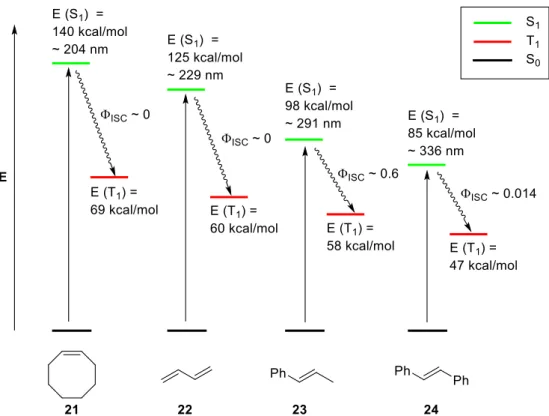
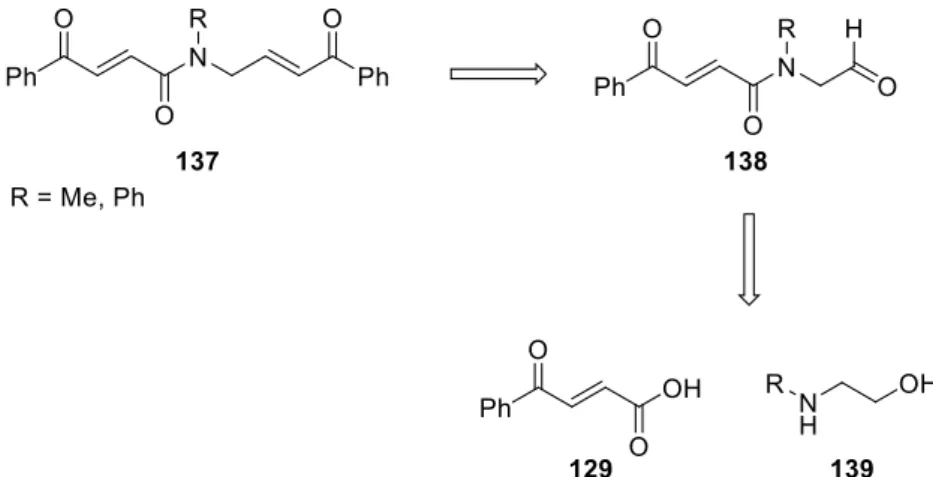
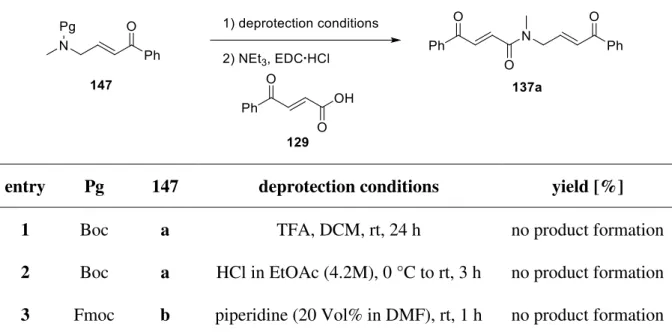
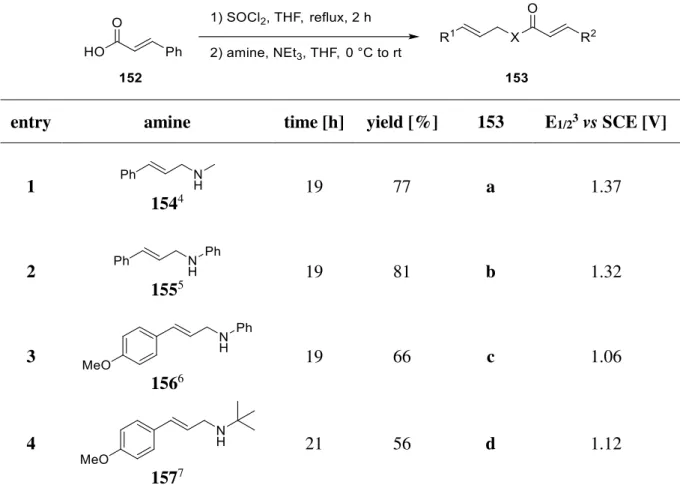
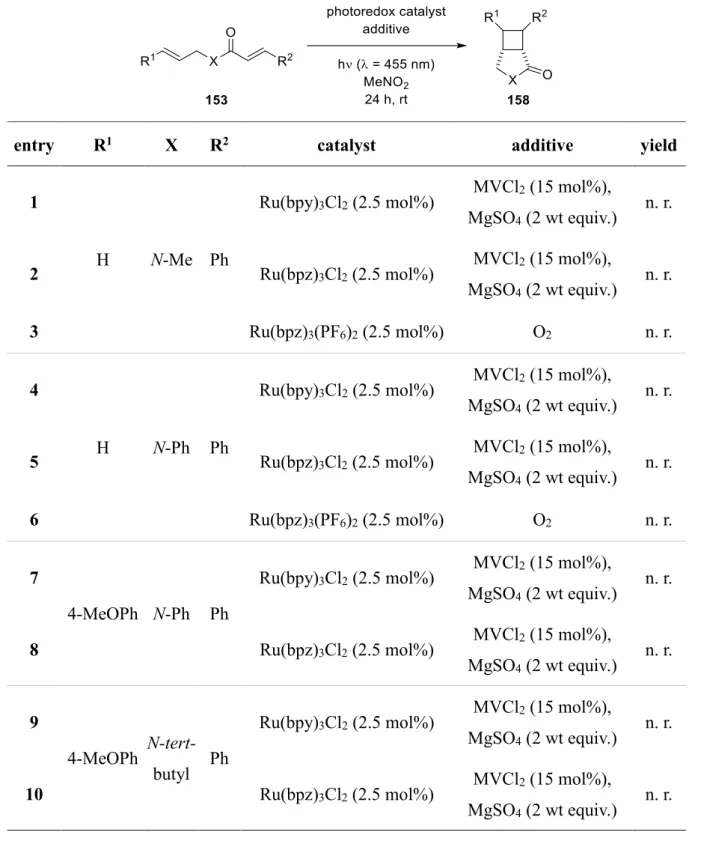
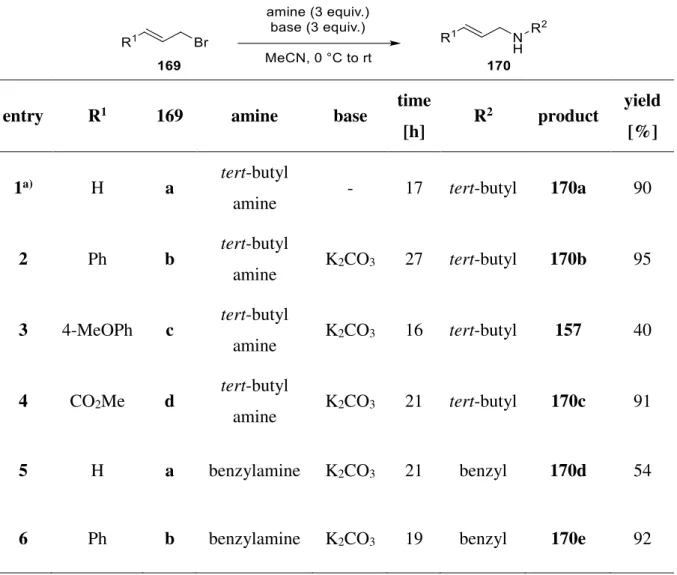
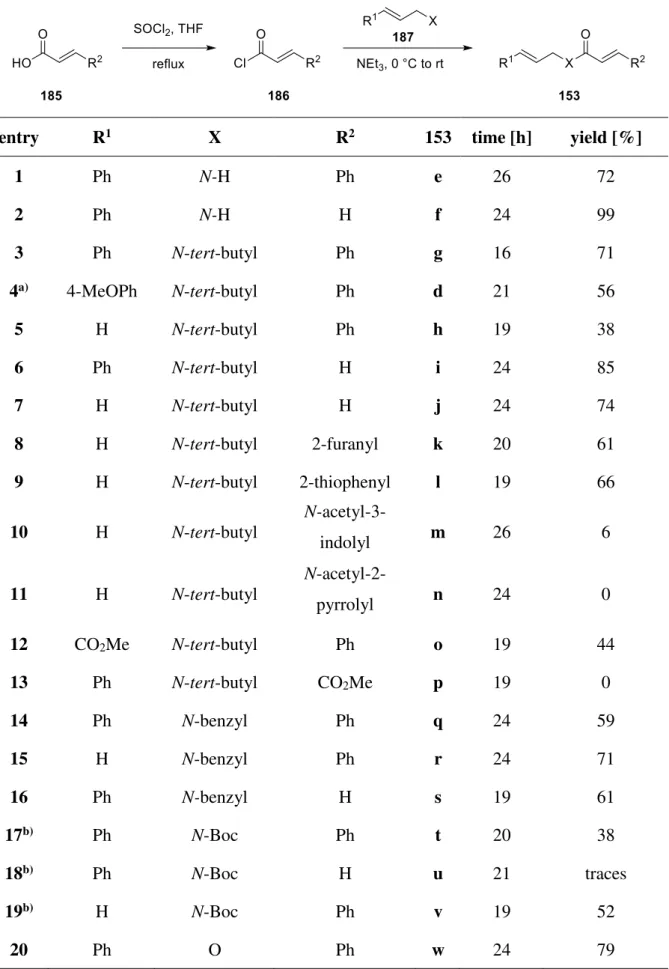
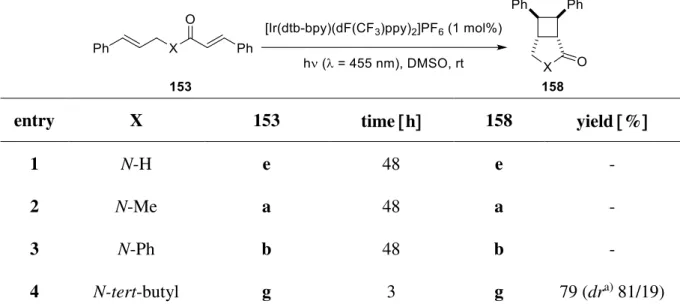
![Table 11. Analysis of the stationary points. entry LOT X K Δ G ≠ [kcal/mol] Δ R G [kcal/mol] 3 NAC 191 - 3 intermediate ( cis ) 192 Δ R G [kcal/mol] 1NAC 190 –1product (cis) 158 1 B3LYP/ 6-311+G** N-H 153e 2.2 • 10 -4 11.5 -15.0 5.6](https://thumb-eu.123doks.com/thumbv2/1library_info/3849506.1515371/60.892.100.790.150.732/table-analysis-stationary-points-entry-lot-intermediate-product.webp)
